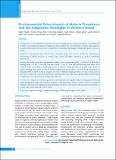Please use this identifier to cite or link to this item:
https://hdl.handle.net/20.500.14356/1203Full metadata record
| DC Field | Value | Language |
|---|---|---|
| dc.contributor.author | Paudel, Uttam | - |
| dc.contributor.author | Pant, Krishna Prasad | - |
| dc.contributor.author | Adhikari, Shiva Raj | - |
| dc.contributor.author | Silwal, Sashi | - |
| dc.contributor.author | Baral, Bimala | - |
| dc.contributor.author | Ghimire, Ghimire | - |
| dc.contributor.author | Adhikari, Sabitri Devi | - |
| dc.contributor.author | Paudel, Sudip | - |
| dc.contributor.author | Poudyal, Anil | - |
| dc.contributor.author | Dhimal, Meghnath | - |
| dc.date.accessioned | 2023-05-02T10:05:36Z | - |
| dc.date.available | 2023-05-02T10:05:36Z | - |
| dc.date.issued | 2021 | - |
| dc.identifier.citation | PaudelU., Prasad PantK., Raj AdhikariS., SilwalS., BaralB., GhimireL., Devi AdhikariS., PaudelS., PoudyalA., & DhimalM. (2022). Environmental Determinants of Malaria Prevalence and the Adaptation Strategies in Western Nepal. Journal of Nepal Health Research Council, 19(04), 754-761. https://doi.org/10.33314/jnhrc.v19i04.2967 | en_US |
| dc.identifier.issn | Print ISSN: 1727-5482; Online ISSN: 1999-6217 | - |
| dc.identifier.uri | http://103.69.126.140:8080/handle/20.500.14356/1203 | - |
| dc.description | Original Article | en_US |
| dc.description.abstract | Abstract Background: Current literatures seem devoted only on relating climate change with malaria. Overarching all possible environmental determinants of malaria prevalence addressed by scanty literature in Nepal is found apposite research at this moment. This study aims to explore the environmental determinants of malaria prevalence in western Nepal. Methods: Cross-sectional data collected from community people were used to identify the environmental determinants of malaria prevalence in western Nepal. Probit and logistic regressions are used for identifying determinants. Results: The results reveal that environmental variables: winter temperature (aOR: 2.14 [95% CI: 1.00-4.56]), flooding (aOR: 2.45 [CI: 1.28-4.69]), heat waves (aOR: 3.14 [CI: 1.16-8.46]) and decreasing river water level (aOR: 0.25 [CI: 0.13-0.47]) are found major factors to influence malaria prevalence in western Nepal. Besides, pipeline drinking water (aOR: 0.37 [0.17-0.81]), transportation facility (aOR: 1.18 [1.07-1.32]) and awareness programs (aOR: 2.62 [0.03-6.65]) are exigent social issues to influence malaria prevalence in Nepal. To be protected from disease induced by environmental problems, households have used extra season specific clothes, iron nets and mosquito nets, use of insecticide in cleaning toilet and so on. Conclusions: Adaptation mechanism against these environmental issues together with promoting pipeline drinking water, transportation facility and awareness programs are the important in malaria control in Nepal. Government initiation with incentivized adaptation mechanism for the protection of environment with caring household attributes possibly help control malaria in western Nepal. Keywords: Adaptation strategy; environmental changes; malaria; probit/logistic model; Nepal. | en_US |
| dc.language.iso | en | en_US |
| dc.publisher | Nepal Health Research Council | en_US |
| dc.relation.ispartofseries | Oct-Dec, 2021;2967 | - |
| dc.subject | Adaptation strategy | en_US |
| dc.subject | environmental changes | en_US |
| dc.subject | malaria | en_US |
| dc.subject | probit/logistic model | en_US |
| dc.subject | Nepal | en_US |
| dc.title | Environmental Determinants of Malaria Prevalence and the Adaptation Strategies in Western Nepal | en_US |
| dc.type | Journal Article | en_US |
| local.journal.category | Original Article | - |
| Appears in Collections: | Vol. 19 No. 04 (2021): Vol 19 No 4 Issue 53 Oct-Dec 2021 | |
Files in This Item:
| File | Description | Size | Format | |
|---|---|---|---|---|
| 2967-Manuscript-26785-1-10-20220313.pdf | Fulltext Download | 698.76 kB | Adobe PDF |  View/Open |
Items in DSpace are protected by copyright, with all rights reserved, unless otherwise indicated.
